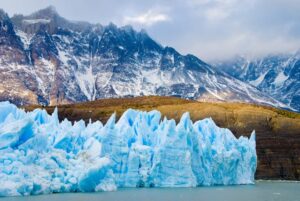Physical Address
23,24,25 & 26, 2nd Floor, Software Technology Park India, Opp: Garware Stadium,MIDC, Chikalthana, Aurangabad, Maharashtra – 431001 India
Physical Address
23,24,25 & 26, 2nd Floor, Software Technology Park India, Opp: Garware Stadium,MIDC, Chikalthana, Aurangabad, Maharashtra – 431001 India

By Aayushi Sharma
The retreat of glaciers is one of the most visually and scientifically significant indicators of climate change. As glaciers recede at an unprecedented rate, the consequences are both alarming and complex. Glaciers play a crucial role in regulating the Earth’s climate by reflecting sunlight and trapping carbon in ice, and their disappearance threatens to accelerate global warming. However, as a recent global study reveals, this process of deglaciation may also offer a silver lining.
The study titled “The Development of Terrestrial Ecosystems Emerging After Glacier Retreat”, published in the journal Nature, suggests that the ecosystems emerging in these post-glacial landscapes could contribute to mitigating climate change. Led by Professor Gentile Francesco Ficetola from the University of Milan and Silvio Marta from Italy’s Institute of Geosciences and Earth Resources, the study is the culmination of a decade of research.
The Dual Impact of Glacial Retreat
While the melting of glaciers has immediate negative impacts on the environment, such as the loss of ice reflectivity (albedo) and the release of stored carbon into the atmosphere, the development of terrestrial ecosystems in these areas can potentially offset some of these effects. The study shows that with proper management, the ecosystems emerging in these deglaciated areas could enhance biogeochemical processes, such as carbon sequestration, and provide vital habitats for species affected by climate change.
The study involved collecting more than 1,200 soil samples from nearly 50 glaciers around the world, including regions with diverse climates, ranging from tropical to subpolar. This massive dataset provided researchers with invaluable insights into how ecosystems form and evolve after glaciers retreat.
In India, Dr. Pritam Chand of Central University, Punjab, and Professor Milap Chand Sharma of Jawaharlal Nehru University, Delhi, contributed to the study by analyzing samples from the Gangotri and Bara Shigri glaciers in the Indian Himalayas.
Early Colonizers: Microorganisms and Pioneer Species
The research revealed that once glaciers retreat, the barren, ice-free land is first colonized by microorganisms like bacteria, protists, and algae. These microorganisms play a vital role in making minerals available for more complex life forms.
According to Dr. Pritam Chand, within a decade of glacier retreat, hardy plants such as lichens, mosses, and grasses begin to establish themselves in these newly formed soils. These pioneer species further enrich the soil, setting the stage for more diverse and complex plant and animal life to follow. The management of these post-glacial ecosystems will be critical in determining their effectiveness in mitigating climate change. As more areas around the world become deglaciated—especially in sensitive regions like the Himalayas and subpolar areas—ensuring that these landscapes develop sustainably will be a key priority.
Dr. Pritam Chand noted that the newly exposed terrains in deglaciated regions are essential for biodiversity. These areas could serve as temporary refuges for species threatened by rising global temperatures. “With proper management, these areas can develop rapidly, providing temporary habitats for species threatened by climate change. Though recently exposed, deglaciated terrains are crucial for biodiversity and could serve as refuges for cold-adapted species,” he said. Additionally, he suggested that promoting wild herbivores in these regions could further enhance life and contribute to the functioning of these ecosystems.
The Himalayan Context: A Vital Area for Ecosystem Study
In India, the study of terrestrial ecosystems emerging from glacial retreat is particularly crucial. The Himalayas, which are home to some of the world’s largest glaciers outside of the polar regions, are already witnessing significant changes due to global warming. These ecosystems are vital for regulating water availability, as the rivers fed by glacial meltwaters provide drinking water, support agriculture, and power hydropower projects for millions of people.
The post-glacial ecosystems of the Himalayas also present opportunities for scientific discovery. As Dr. Pritam Chand pointed out, the biodiversity in these newly exposed areas holds potential for medicinal and agricultural discoveries. Moreover, these ecosystems could provide a foundation for eco-tourism, offering local communities a sustainable way to benefit economically from the changing landscape.
References:
https://nsidc.org/learn/parts-cryosphere/glaciers/why-glaciers-matter
https://www.nature.com/articles/s41586-024-07778-2
https://mynasadata.larc.nasa.gov/mini-lessonactivity/what-albedo
Banner Image: Photo by Pixabay https://www.pexels.com/photo/panoramic-view-of-landscape-against-sky-255329/
Photo by Francesco Ungaro https://www.pexels.com/photo/iceberg-on-body-of-water-digital-wallpaper-464345/